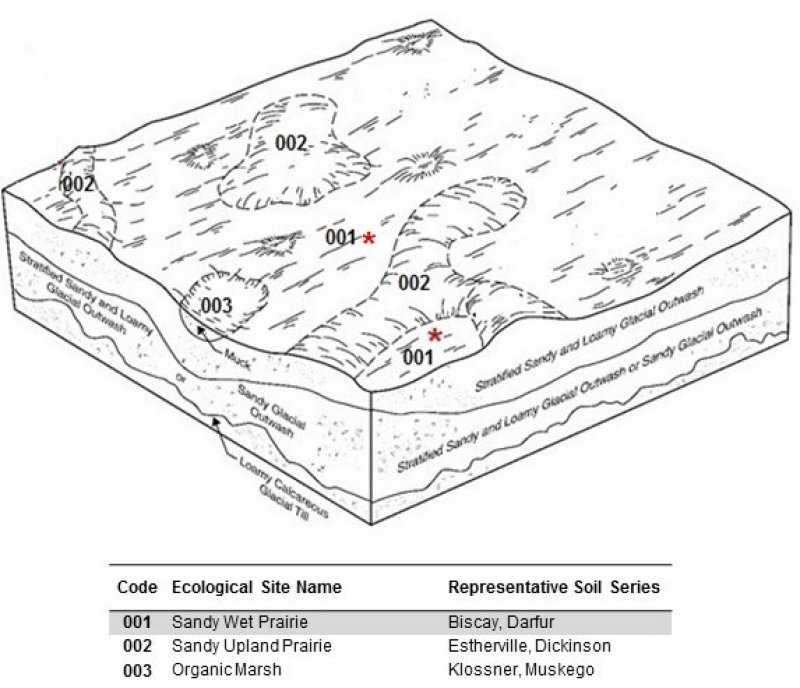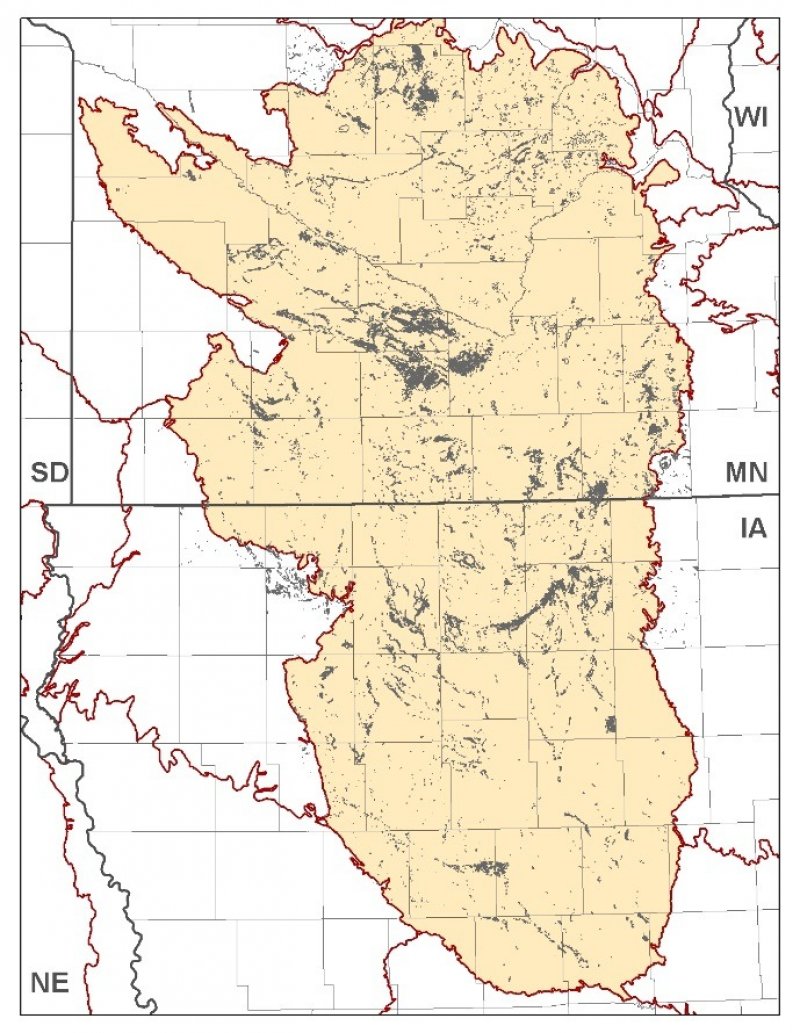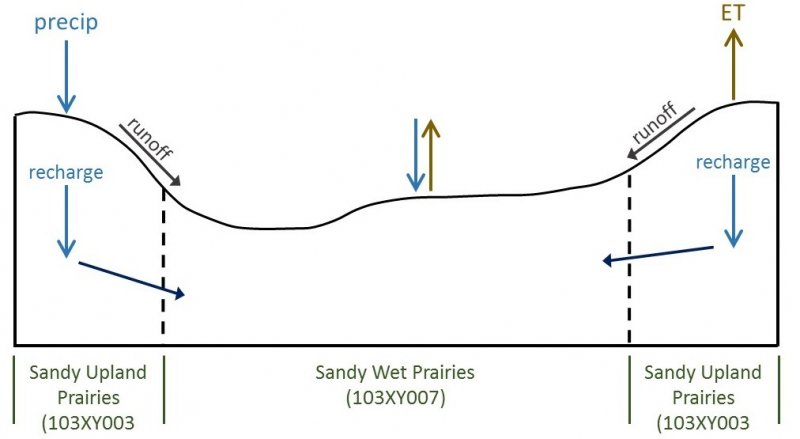Ecological dynamics
The Sandy Wet Prairie ecological site is characterized by three states: the Reference State, the Tillage State, and the Woodland State. Two plant communities exist in the Reference State and are characterized by different fire return intervals. Fire and grazing are triggers for change on this ecological site. The Tillage State describes sites that have been tilled and generally have modified hydrology. Two communities make up the Tillage State: the Row Crop Community and the Seeded Grassland Community. The Woodland State is a disturbed wooded state. Disturbances may include lack of natural fire, unmanaged grazing, and non-native species.
State 1
Reference State
The Sandy Wet Prairies ecological site reference is a wet to wet-mesic prairie that includes a diversity of wet-tolerant grasses and forbs. Variation in water table allows both wetland and non-wetland species to thrive on this site. Grass species include prairie cordgrass, big bluestem, and Indiangrass. Sedges are an important component, especially in wetter areas. Several dozen species are possible. The most noteworthy species are Bicknell’s sedge (Carex bicknellii Britton), woolly sedge (Carex pellita Muhl ex. Willd.), and Buxbaum’s sedge (Carex buxbaumii Wahlen B.). Tussock-forming species like Hayden’s sedge (Carex haydenii Dewey) and upright sedge (Carex stricta Lam.) may also be important in wet conditions. Common forbs include classic tallgrass prairie species like prairie blazing star (Liatris pycnostachya Michx.) and compassplant (Silphium laciniatum L.), as well as species typical of wetland conditions like four flower yellow loosestrife (Lysimachia quadriflora Sims) and swamp milkweed (Asclepias incarnata L.). Shrub cover was typically low and likely included leadplant (Amorpha canescens Pursh), willows (Salix L.) and dogwoods
(Cornus L.), which quickly spread in the absence of frequent fire.
Community phases within the reference state are generally dependent upon the impacts of fire or grazing. Fire is a trigger that occurs during dry periods and promotes continued herbaceous vegetation dominance and removes dense thatch. This promotes seedling regeneration. Fire removes plant litter, helps cycle nutrients, and allows light to reach the seedbed. Frequent fire maintains the community in a grassland state by keeping fire-sensitive woody species from gaining dominance. A secondary trigger for maintenance or conversion of this ecological site is grazing. Intensive grazing can reduce the extent of highly palatable species thereby allowing the growth of less desirable plants to increase.
Community 1.1
High Diversity Prairie
This plant community is composed of wet-tolerant native grasses along with a variety of native forbs. The vegetative composition is influenced by fire return intervals of less than 3 years. Frequent fire reduces fire-intolerant woody species and maintains the natural dominance and diversity of native grasses and forbs. Fire also stimulates seed regeneration and reduces the amount of thatch. Managed grazing may also be a trigger to maintain and promote a diverse grassland community. A diversity of native forbs are present on these sites.
Community 1.2
Old Growth Prairie
This plant community is characterized by a fire return interval longer than three years which allows for an increase in woody species and thatch buildup. Thatch can reduce herbaceous plant regeneration through blockage and shading. Although this community has a longer fire return interval than Community 1.1, it also relies on fire and/or grazing to maintain vegetation community structure. Prescribed grazing management may also be used to manage community structure, plant health, regeneration, and vigor. By incorporating periods of rest and recovery during the growing season, landowners can insure that the palatable grasses and forbs are maintained as dominants within the community.
Resilience management. Prescribed fire and grazing are resilience management practices. Prescribed fire is the controlled application of fire to modify vegetation structure and influence ecological processes.
Pathway 1.1A
Community 1.1 to 1.2
An decrease in fire frequency will allow for an increase in woody vegetation within the community.
Pathway 1.2A
Community 1.2 to 1.1
An increase in fire frequency will reduce woody vegetation and thatch plus enhance regeneration of native grasses and forbs.
State 2
Tillage State
Soil tillage and hydrological modification (ditching, tiling) are the primary mechanisms transitioning this site to a Tillage State. Tillage alters dynamic soil properties such as bulk density, structure, organic carbon content, and saturated hydraulic conductivity. Most areas in this state will remain in use for crop production in the foreseeable future – primarily in an intensive corn and soybean rotation. Certain practices can mitigate the soil health impacts of traditional agricultural practices. Conservation tillage minimizes soil disturbance and can improve soil structure and overall soil health. Corn or soybean plantings and a cover crop rotation can build soil structure, improve infiltration rates, reduce runoff and erosion, and protect water quality.
A few areas within the Sandy Wet Prairies ecological site have been seeded back to grasses. Under conservation programs. Native grasses and forbs benefit wildlife and pollinators; however, these sites generally lack the diversity of a reference state condition. Cool-season grasses are also feasible. Species selection will depend on the landowner's objectives and site specifics.
Community 2.1
Tillage Community
This plant community typically consists of traditional row crops. Tillage, drainage, and intentional plant establishment (crop seeding) are the primary triggers for this community. The most common crops are corn and soybeans on an annual rotation.
Community 2.2
Seeded Grassland
Community 2.2. includes areas that were previously tilled and used for agricultural production but have been transitioned to either warm-season or cool-season grasses. The primary trigger is the intentional establishment of a grassland community. Warm-season grasses are commonly planted under a NRCS conservation program. Seed mixes include native forbs that benefit wildlife and pollinators. Seed mix selection depends on existing hydrological conditions and landowner objectives.
Landowners may choose to establish cool-season grass species. Multiple cool-season grasses can be planted, depending on management objectives. Many of these areas are eventually transitioned to annual crop production.
Resilience management. Resilience management practices include invasive plant management, woody species control, and a program of planned grazing.
Pathway P2.1
Community 2.1 to 2.2
Seeding of either warm season or cool season grass species is the mechanism of change from Community 2.1. to 2.2.
| Forage and Biomass Planting |
|
Pathway P2.2
Community 2.2 to 2.1
Returning the area to row crop production is the mechanism of change from Community 2.2 to 2.1. Common management inputs include tillage, seeding, weed control, and fertilizing.
State 3
Woodland State
The absence of a natural disturbances, such as fire, can revert areas to the Wooded State. These sites often have other disturbances such as unmanaged grazing, altered hydrology, and invasive species. Community composition and characteristics will vary depending on seed sources and the type, severity, and length of disturbances. Tree species often include eastern cottonwood, black willow, green ash, and boxelder. Shrubs include dogwood and willow.
State 3 may be a conservation easement. Areas not in a conservation program are assumed to be jurisdictional wetlands, making it unlikely they will be transitioned to State 2 due to various wetland programs and laws, including the Swampbuster provision of the Food Security Act of 1985 (P.L. 99-198, as amended by P.L. 115-25) and the Minnesota Wetland Conservation Act (WCA) of 1991 (M.R. 8420.0100, as amended in 2009).
Community 3.1
Woodland Community
This site is a woodland community consisting of various species of trees, shrubs, and often, non-native species. Common trees include eastern cottonwood, black willow, boxelder, and green ash. Open areas may be dominated by reed canarygrass and other cool-season, non-native grasses. Plant community composition will be determined by past disturbances, seed sources, and current disturbances.
Transition T1A
State 1 to 2
Reference site is transitioned to agricultural uses. Multiple management inputs are possible depending on site characteristics and landowner objectives. Common inputs include ditching, tiling, tillage and seeding of desired crop or grass species.
Transition T1B
State 1 to 3
Plant community succession via the lack of natural fire and/or grazing. Brush and trees will increase and plant community structure will begin to move from a prairie to a woodland.
Restoration pathway R3A
State 3 to 1
Sites that have not been tilled and still have natural hydrologic functions may be feasible to restore back to a reference community. Soil structure is intact, hydrology is natural, and remnant plant communities may still exist on site.



